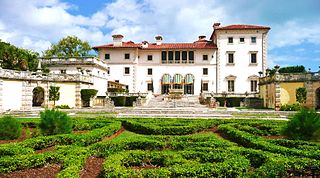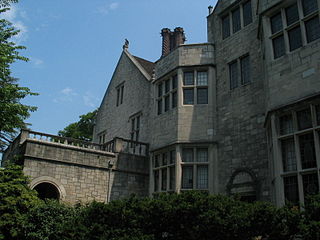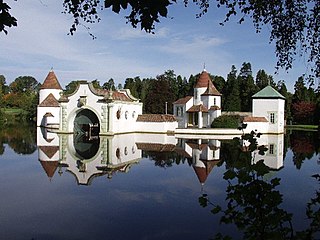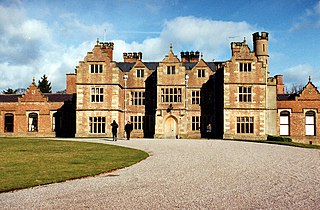
Blickling Hall is a Jacobean stately home situated in 5,000 acres of parkland in a loop of the River Bure, near the village of Blickling north of Aylsham in Norfolk, England. The mansion was built on the ruins of a Tudor building for Sir Henry Hobart from 1616 and designed by Robert Lyminge. The library at Blickling Hall contains one of the most historically significant collections of manuscripts and books in England, containing an estimated 13,000 to 14,000 volumes. The core collection was formed by Sir Richard Ellys. The property passed into the care of the National Trust in 1940.

Iford Manor is a manor house in Wiltshire, England. It is a Grade II* listed building sitting on the steep, south-facing slope of the Frome valley, in Westwood parish, about 2 miles (3.2 km) southwest of the town of Bradford-on-Avon. Its Grade I registered gardens are open to the public from April to September each year.

Jens Jensen was a Danish-American landscape architect.

The Vizcaya Museum and Gardens, previously known as Villa Vizcaya, is the former villa and estate of businessman James Deering, of the Deering McCormick-International Harvester fortune, on Biscayne Bay in the present-day Coconut Grove neighborhood of Miami, Florida. The early 20th-century Vizcaya estate also includes extensive Italian Renaissance gardens, native woodland landscape, and a historic village outbuildings compound.

Prior Park Landscape Garden surrounding the Prior Park estate south of Bath, Somerset, England, was designed in the 18th century by the poet Alexander Pope and the landscape gardener Capability Brown, and is now owned by the National Trust. The garden was influential in defining the style known as the "English landscape garden" in continental Europe. The garden is Grade I listed in the Register of Historic Parks and Gardens of special historic interest in England.

The Arnold Arboretum of Harvard University is a botanical research institution and free public park, located in the Jamaica Plain and Roslindale neighborhoods of Boston, Massachusetts. Established in 1872, it is the oldest public arboretum in North America. The landscape was designed by Charles Sprague Sargent and Frederick Law Olmsted and is the second largest "link" in the Emerald Necklace. The Arnold Arboretum's collection of temperate trees, shrubs, and vines has a particular emphasis on the plants of the eastern United States and eastern Asia, where arboretum staff and colleagues are actively sourcing new material on plant collecting expeditions. The arboretum supports research in its landscape and in its Weld Hill Research Building.

The Gardens at Elm Bank, home of Massachusetts Horticultural Society, occupies 36 acres (15 ha) of Elm Bank Reservation, a 175-acre (71 ha) recreational area of woodlands, fields, and former estate property on the Charles River managed by the Massachusetts Department of Conservation and Recreation. The estate's entrance is located at 900 Washington Street, Wellesley, Massachusetts, United States, with the major portion of the grounds located in the neighboring town of Dover. In 1987, the entire site was added to the National Register of Historic Places as Elm Bank.

Bute Park and Arboretum is a park in Cardiff, Wales. It comprises 130 acres (53 ha) of landscaped gardens and parkland that once formed the grounds of Cardiff Castle. The park is named after the 3rd Marquess of Bute, whose family owned the castle.

Vanderbilt Mansion National Historic Site is a historic house museum in Hyde Park, New York. It became a National Historic Landmark in 1940. It is owned and operated by the National Park Service.

The English landscape garden, also called English landscape park or simply the English garden, is a style of "landscape" garden which emerged in England in the early 18th century, and spread across Europe, replacing the more formal, symmetrical French formal garden which had emerged in the 17th century as the principal gardening style of Europe. The English garden presented an idealized view of nature. Created and pioneered by William Kent and others, the “informal” garden style originated as a revolt against the architectural garden and drew inspiration from paintings of landscapes by Salvator Rosa, Claude Lorrain, and Nicolas Poussin.

Planting Fields Arboretum State Historic Park, which includes the Coe Hall Historic House Museum, is an arboretum and state park covering over 400 acres (160 ha) located in the village of Upper Brookville in the town of Oyster Bay, New York.

Bicton is a civil parish and a former manor in the East Devon district of Devon, England, near the town of Budleigh Salterton. The parish is surrounded, clockwise from the north, by the parishes of Colaton Raleigh, Otterton, East Budleigh and Woodbury. According to the 2001 census it had a population of 280. Much of the parish consists of Bicton Park, the historic home of the Rolle family, with Bicton Common, adjacent to Woodbury Common, in the west. The parish includes the village of Yettington on its southern border.

Painshill, near Cobham, Surrey, England, is one of the finest remaining examples of an 18th-century English landscape park. It was designed and created between 1738 and 1773 by Charles Hamilton. The original house built in the park by Hamilton has since been demolished.

Hestercombe House is a historic country house in the parish of West Monkton in the Quantock Hills, near Taunton in Somerset, England. The house is a Grade II* listed building and the estate is Grade I listed on the English Heritage Register of Parks and Gardens of Special Historic Interest in England.

Stephen Switzer (1682–1745) was an English gardener, garden designer and writer on garden subjects, often credited as an early exponent of the English landscape garden. He is most notable for his views of the transition between the large garden, still very formal in his writings, and the surrounding countryside, especially woodland.

Craigtoun Country Park is a country park located approximately 4 miles to the south-west of St Andrews in the county of Fife, Scotland. The site is currently owned by Fife Council, with park amenities being operated as of 2012 by the charitable organisation Friends of Craigtoun Park.

Untermyer Park and Gardens is a historic 43-acre (17 ha) city public park, located in Yonkers, New York in Westchester County, just north of New York City. The park is a remnant of Samuel Untermyer's 150-acre (61 ha) estate "Greystone". Situated on the steep land arising from the eastern bank of the Hudson River to the bluff on top of it, the park's principal feature is the Walled Garden, inspired by ancient Indo-Persian gardens, in which are found a small Grecian-style open-air amphitheater with two opposing sphinxes crouching atop paired Ionic columns; a classical pavilion; a stoa and loggias; and a circular, open-air tempietto called the Temple of the Sky. A long staircase leads from the Walled Garden to an Overlook with views of the river and the Palisades.

Nielsen Park is a heritage-listed historic site, park and nature reserve located at Greycliffe Avenue, Vaucluse in the Municipality of Woollahra local government area of New South Wales, Australia. The traditional lands of the Birrabirragal indigenous people, the park was designed by John Frederick Hilly, James Barnet and the Office of the New South Wales Government Architect. It is also known as Vaucluse Estate, Greycliffe Estate and Greycliffe House. It was added to the New South Wales State Heritage Register on 28 August 2017.

Royden Park is a park in Frankby, Wirral, England, managed by Wirral Council. The grounds of the park were originally part of an estate owned by Ernest Royden which comprised the park, Hill Bark house and Thurstaston Common. Upon his death the estate passed to Hoylake council and was opened to the public for recreation. The park features a visitor centre, walled garden, miniature railway, woodland walks and a lake.

Brynkinalt Hall is a Grade-II* listed private property, built in 1612, near Chirk, Wrexham County Borough, Wales. The hall is surrounded by an estate including 1,000 acres (4.0 km2) of agricultural land and 400 acres (1.6 km2) of woodland. Part of the estate extends into Shropshire, England. Brynkinalt Park is a park located to the hall's north-west.



















